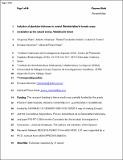Por favor, use este identificador para citar o enlazar a este item:
http://hdl.handle.net/10261/348518COMPARTIR / EXPORTAR:
 SHARE SHARE
 CORE
BASE CORE
BASE
|
|
| Visualizar otros formatos: MARC | Dublin Core | RDF | ORE | MODS | METS | DIDL | DATACITE | |

| Título: | Induction of Glandular Trichomes to Control Bemisia tabaci in Tomato Crops: Modulation by the Natural Enemy Nesidiocoris tenuis |
Autor: | Riahi, Chaymaa; Urbaneja, Alberto CSIC ORCID; Fernández-Muñoz, Rafael; Fortes, Isabel M; Moriones, Enrique; Pérez-Hedo, Meritxell | Palabras clave: | Bemisia tabaci Acylsugars Defense induction Tomato Type IV glandular trichomes Whitefly-transmitted viruses |
Fecha de publicación: | sep-2023 | Editor: | American Phytopathological Society | Citación: | Phytopathology | Resumen: | Whitefly-transmitted viruses are one of the biggest threats to tomato (Solanum lycopersicum) growing worldwide. Strategies based on the introgression of resistance traits from wild relatives are promoted to control tomato pests and diseases. Recently, a trichome-based resistance characterizing the wild species Solanum pimpinellifolium was introgressed into a cultivated tomato. An advanced backcross line (BC5S2) exhibiting the presence of acylsugar-associated type IV trichomes, which are lacking in cultivated tomatoes, was effective at controlling whiteflies (Hemiptera: Aleyrodidae) and limiting the spread of whitefly-transmitted viruses. However, at early growth stages, type IV trichome density and acylsugar production are limited; thus, protection against whiteflies and whitefly-transmitted viruses remains irrelevant. In this work, we demonstrate that young BC5S2 tomato plants feeding-punctured by the zoophytophagous predator Nesidiocoris tenuis (Hemiptera: Miridae) displayed an increase (above 50%) in type IV trichome density. Acylsugar production was consistently increased in N. tenuis-punctured BC5S2 plants, which was more likely associated with upregulated expression of the BCKD-E2 gene related to acylsugar biosynthesis. In addition, the infestation of BC5S2 plants with N. tenuis effectively induced the expression of defensive genes involved in the jasmonic acid signaling pathway, resulting in strong repellence to Bemisia tabaci and attractiveness to N. tenuis. Thus, through preplant release of N. tenuis in tomato nurseries carried out in some integrated pest management programs, type IV trichome-expressing plants can be prepared to control whiteflies and whitefly-transmitted viruses at early growth stages. This study emphasizes the advantage of reinforcing constitutive resistance using defense inducers to guarantee robust protection against pests and transmitted viruses. | URI: | http://hdl.handle.net/10261/348518 | DOI: | 10.1094/PHYTO-11-22-0440-V | ISSN: | 0031-949X |
| Aparece en las colecciones: | (IHSM) Artículos |
Ficheros en este ítem:
| Fichero | Descripción | Tamaño | Formato | |
|---|---|---|---|---|
| PHYTO-11-22-0440-first look.pdf | Preprint Riahi 2023 | 555,53 kB | Adobe PDF |  Visualizar/Abrir |
CORE Recommender
SCOPUSTM
Citations
2
checked on 23-abr-2024
WEB OF SCIENCETM
Citations
2
checked on 28-feb-2024
Page view(s)
19
checked on 27-abr-2024
Download(s)
71
checked on 27-abr-2024
Google ScholarTM
Check
Altmetric
Altmetric
NOTA: Los ítems de Digital.CSIC están protegidos por copyright, con todos los derechos reservados, a menos que se indique lo contrario.
